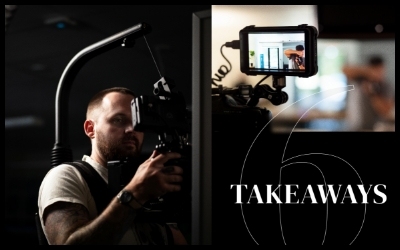Drone technology has evolved quickly over the past decade. What were your first experiences flying, and how have things changed?
Lew: In 2015, drones were gaining some word-of-mouth traction as an exciting new photography platform, so that’s when they first hit our radar (no pun intended). As a cinematographer, I’m always looking for new tools and techniques that we can use to create interesting shots and tell better stories for our clients. I had never flown a drone in any capacity, so there was a lot of trial and error early on.
These were also pretty basic drones — no GPS, no camera. We would mount a GoPro on a gimbal to the drone, point it (hopefully) in the right direction, and send it up into the sky. We had to wait until we got it back and checked the camera to see if we had achieved what we wanted visually.
Today’s drone technology provides a live feed of what the camera is capturing. It even has a video of the drone itself, allowing me to know exactly where the drone is oriented. New drones are also equipped with camera stabilization and obstacle avoidance sensors, making them almost foolproof. These features let me home in on what’s most important: the shot.
Can you tell us about the FAA licensure process?
Lew: In 2016 and 2017, we saw drones gaining popularity, both recreationally and professionally. With more drones in the sky, the FAA started to get more aggressive with their guidelines for flying them, including the creation of no-fly zones, registration requirements and pilot licensing. This made it mandatory for anyone flying drones commercially to maintain an active Remote Pilot Certification.
It wasn’t like obtaining a driver’s license, where someone tests your ability to operate a motor vehicle, or in this case a drone. Instead, I had to pass an aeronautical knowledge test that covered things such as emergency procedures, preflight inspections and operating drones at night. To maintain my license, I’m required to complete an online recurring training every two years.
What have been some of the highlights for you as a drone pilot/cinematographer?
Lew: Things got really interesting when, in 2016, Wray Ward took the drone to Europe for Sunbrella’s “Uncharted Waters,” a documentary film celebrating US Sailing Team athletes. I flew in Spain, France and Holland, often going out on the water to capture amazing aerial shots of the sailboats and athletes. I’ll admit, launching and controlling a drone from a moving boat was a nerve-wracking experience!
Having access to drone photography has been really valuable for our clients in the home and building category, especially for showcasing their products in real-life installation scenarios. Without a drone, photographing large-scale construction projects requires renting a crane — or even a helicopter — to film that overhead perspective. This takes a lot of people, a lot of planning and a lot of money. With a drone, I can often get that same shot by myself in 15 minutes.
That’s where using drone video has been a great resource for our work with VELUX skylights, for example. It was always a little tricky to shoot and showcase a skylight — even when you are up on the roof, the perspective isn’t great. With a drone, we can get above everything and capture a full shot of the penetration in the roof with the installers setting the skylight. It’s a great way to tell that story.
How does Wray Ward currently approach the use of drone photography for client work?
Lew: Given its ability to provide unique and compelling visuals that resonate with audiences, drone photography has become a standard consideration for every visual campaign we execute for a client.
Some of our recent drone projects include work for Charlotte Pipe and Foundry and Brighthouse Financial. For Charlotte Pipe, I piloted a drone inside their new 11-acre cast iron foundry in Oakboro, North Carolina, to capture some unique perspectives of their equipment and employees in action.
We also recently shot a Brighthouse Financial commercial that featured a roller coaster as an analogy for the ups and downs of the financial market. The drone allowed me to capture compelling video that helped pull the audience into the ad and make them feel like they were on the ride.
Aerial shots like these add dynamism and depth to a narrative, making it more engaging and memorable for viewers and helping us, as advertisers, tell immersive stories from unconventional angles.


